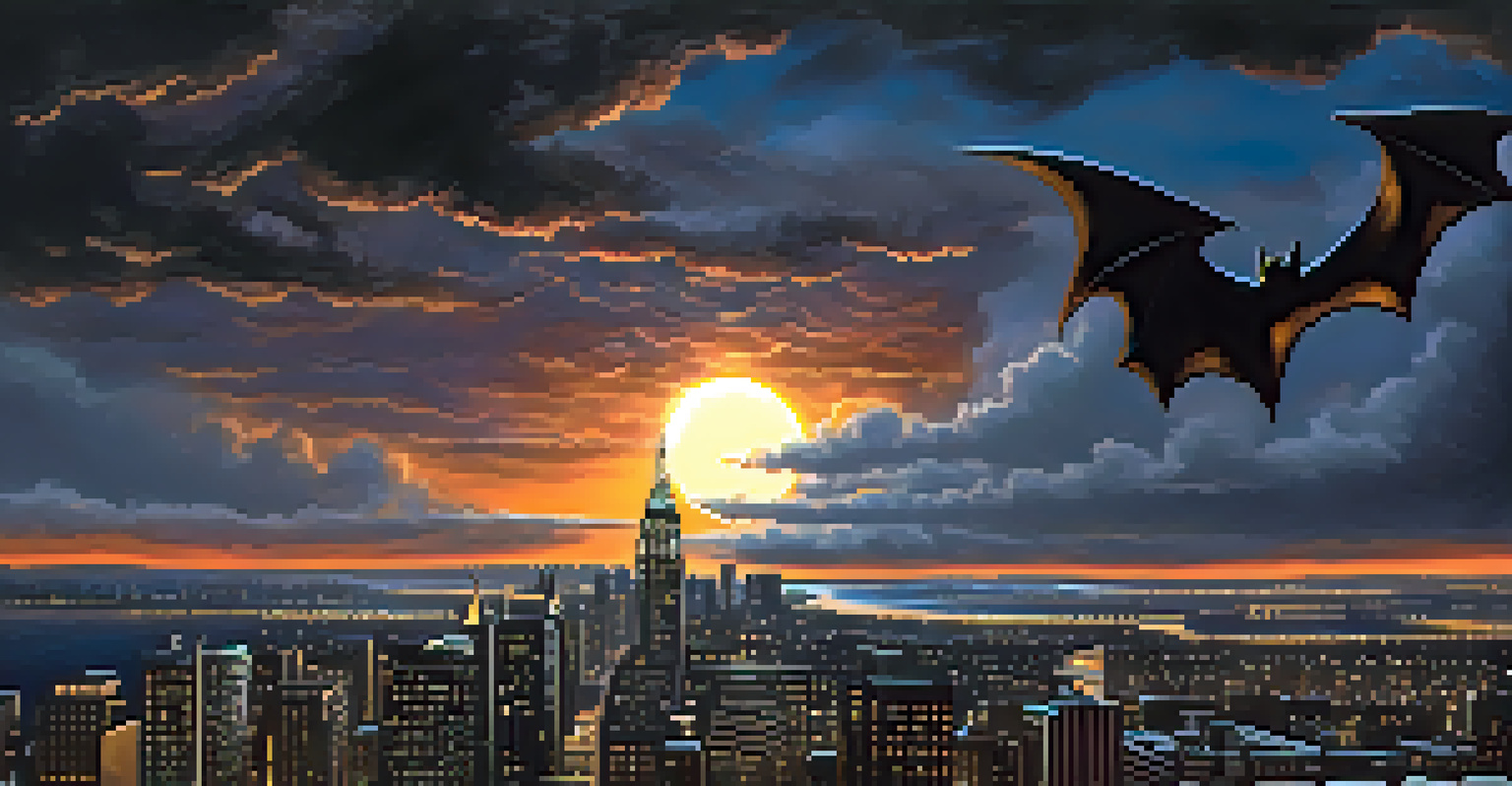Iconic Symbols in Film: Their Meaning and Cultural Significance

The Power of Symbols: An Introduction to Film Imagery
Symbols in film serve as visual shorthand, conveying complex ideas quickly. They are often used to represent deeper themes, emotions, or cultural narratives, allowing audiences to connect on a subconscious level. Just like a flag represents a nation, a symbol in film can evoke a range of feelings and interpretations, depending on the viewer's background and experiences.
Symbols are the language of the soul; they speak to us in ways that words cannot.
For instance, the use of color can symbolize different emotions; red often signifies passion or danger, while blue can evoke calmness or sadness. These visual cues not only enhance storytelling but also enrich the viewer's experience, making films more memorable and impactful. Understanding these symbols adds another layer of enjoyment and insight into the film's message.
As we delve deeper into iconic symbols, we'll explore specific examples from various films and discuss their meanings and significance in different cultural contexts. Each symbol has its own story, much like the films they inhabit, and uncovering these layers can lead to a greater appreciation of cinematic art.
The Red Rose: A Symbol of Love and Desire in Cinema
The red rose has long been associated with love, passion, and desire, making it a powerful symbol in film. Its presence often signifies romantic moments, heightening the emotional stakes of a scene. For example, in 'American Beauty,' the red rose petals represent both beauty and the underlying chaos of the characters' lives, illustrating the duality of desire.

In addition to romantic love, the red rose can also symbolize longing or unfulfilled desire, as seen in films like 'The Great Gatsby.' Here, the rose serves as a reminder of dreams and aspirations that may never be realized, adding depth to the narrative. This dual symbolism makes the red rose a versatile and poignant element in storytelling.
Symbols Enhance Film's Impact
Symbols in film serve as powerful visual tools that convey complex themes and emotions, enriching the audience's experience.
By understanding the cultural significance of the red rose in films, audiences can appreciate the layers of meaning behind this seemingly simple symbol. It serves as a reminder that love, like film, is often complex, multifaceted, and influenced by both personal and societal contexts.
The Iconic Use of the Pearls: Elegance and Status
Pearls in film often symbolize elegance, sophistication, and status, frequently associated with characters who embody these traits. For instance, in 'Breakfast at Tiffany's,' Holly Golightly's pearls represent her desire for luxury and the glamorous lifestyle she aspires to achieve. They become a visual representation of her character's complexities and dreams.
A picture is worth a thousand words, but a symbol can inspire a million thoughts.
Beyond mere adornment, pearls can also signify vulnerability and the hidden depths of a character. In 'The Great Gatsby,' Daisy Buchanan's pearls symbolize both her wealth and her emotional fragility, serving as a reminder that beauty can mask deeper issues. This duality adds richness to the narrative and invites viewers to look beyond the surface.
By examining the role of pearls in various films, we can gain insight into the societal values and expectations surrounding wealth and femininity. As symbols, they challenge us to consider what lies beneath the surface and how appearances can often be deceiving.
The Bat Signal: Justice and Hope in Superhero Films
The Bat Signal is an iconic symbol of justice, hope, and the presence of a protector. Used primarily in the Batman franchise, this symbol communicates a call for help and the promise of safety in Gotham City. When the Bat Signal lights up the night sky, it serves as a reminder that someone is watching over the city—and that justice will prevail.
This powerful symbol also embodies the duality of fear and safety, as Batman himself is both a figure of dread for criminals and a beacon of hope for citizens. The Bat Signal's presence in the dark night sky evokes a sense of security and reassurance that good will triumph over evil. This interplay of light and darkness adds depth to the narrative, making it resonate with audiences.
Cultural Context Shapes Symbolism
The interpretation of symbols, such as the red rose or American flag, is influenced by cultural backgrounds and societal values.
By understanding the cultural significance of the Bat Signal, viewers can appreciate its role in shaping the superhero genre. It transcends mere imagery, representing the universal themes of justice, sacrifice, and the enduring human spirit.
The American Flag: Patriotism and Identity in Film
The American flag is a potent symbol of patriotism, identity, and the values associated with the United States. In films, it often appears during pivotal moments to evoke a sense of national pride or to underscore themes of sacrifice and unity. Movies like 'Saving Private Ryan' and 'Forrest Gump' use the flag to represent both the struggles and triumphs of the American experience.
However, the flag can also serve as a critique of American ideals, highlighting the contradictions inherent in the nation's history. In films such as 'American History X,' the flag becomes a symbol of division and hate, prompting viewers to reflect on the complexities of national identity. This duality makes the American flag a rich symbol for filmmakers to explore.
By examining the varied representations of the American flag in cinema, audiences can engage in meaningful conversations about patriotism and the evolving nature of identity. It encourages us to question what it means to belong to a nation and how symbols shape our understanding of history.
The Eye: A Symbol of Knowledge and Perception
The eye is a multifaceted symbol in film, often representing knowledge, perception, and the quest for truth. It can signify the characters' awareness of their surroundings or their inner selves, as seen in films like 'Eyes Wide Shut.' Here, the eye becomes a metaphor for the characters' exploration of hidden desires and the complexities of human relationships.
Moreover, the eye can also symbolize the audience's gaze, prompting reflections on how we perceive the world through a cinematic lens. In 'The Truman Show,' the eye represents surveillance and the idea of being watched, raising questions about reality and authenticity. This layered symbolism invites viewers to consider their own perspectives and biases.
Symbols Foster Deeper Connections
Understanding the meanings behind symbols in cinema encourages viewers to engage more profoundly with the narratives and emotions presented.
By recognizing the significance of the eye as a symbol in film, we can appreciate the deeper themes of knowledge and perception woven into the narrative. It encourages us to reflect on how our understanding of truth is shaped by what we choose to see—or ignore.
The Cross: Faith, Sacrifice, and Redemption in Film
The cross is a powerful symbol of faith, sacrifice, and redemption, often featured prominently in films exploring spiritual themes. It serves as a reminder of the struggles and triumphs of the human spirit, as seen in films like 'The Passion of the Christ.' Here, the cross represents both suffering and the promise of salvation—a poignant reminder of the power of hope.
In addition to its religious connotations, the cross can also symbolize the burden of choice and the weight of moral responsibility. In 'Dead Man Walking,' the cross becomes a symbol of redemption and forgiveness, illustrating the complex interplay of justice and mercy. This nuanced portrayal invites viewers to engage with their own beliefs and values.

By examining the role of the cross in various cinematic narratives, we can better understand how it shapes our perceptions of faith and morality. It encourages us to consider the profound impact of symbols on our understanding of the world and our place within it.
Conclusion: The Enduring Power of Symbols in Film
As we've explored, symbols in film are not just decorative elements; they carry profound meanings and cultural significance. From the red rose to the Bat Signal, each symbol invites us to delve deeper into the themes and narratives presented on screen. By recognizing and interpreting these symbols, we enrich our viewing experience and cultivate a deeper understanding of the stories being told.
Moreover, symbols can bridge cultural divides, allowing diverse audiences to connect over shared experiences and emotions. They serve as a universal language that transcends barriers, reminding us of our collective humanity. In a world where narratives shape perceptions, understanding the power of symbols becomes increasingly vital.
Ultimately, the enduring power of symbols in film lies in their ability to evoke emotions, provoke thought, and inspire change. As we continue to engage with cinematic art, let us remain curious about the meanings behind the symbols, for they hold the key to unlocking the deeper stories that resonate within us all.